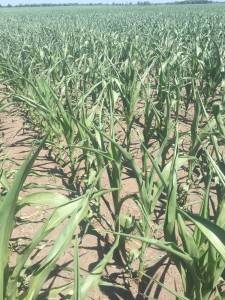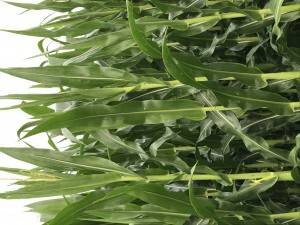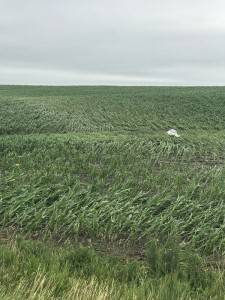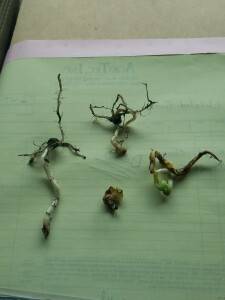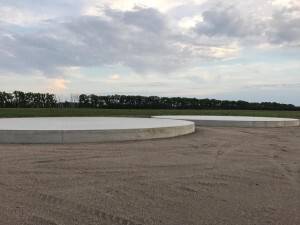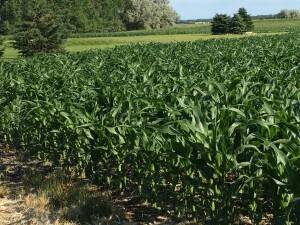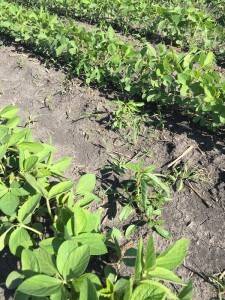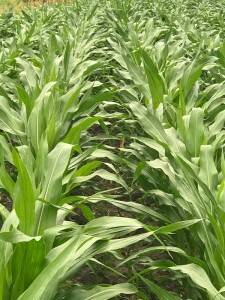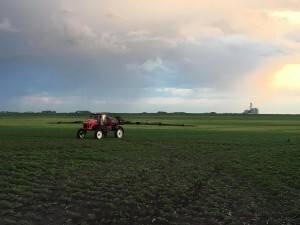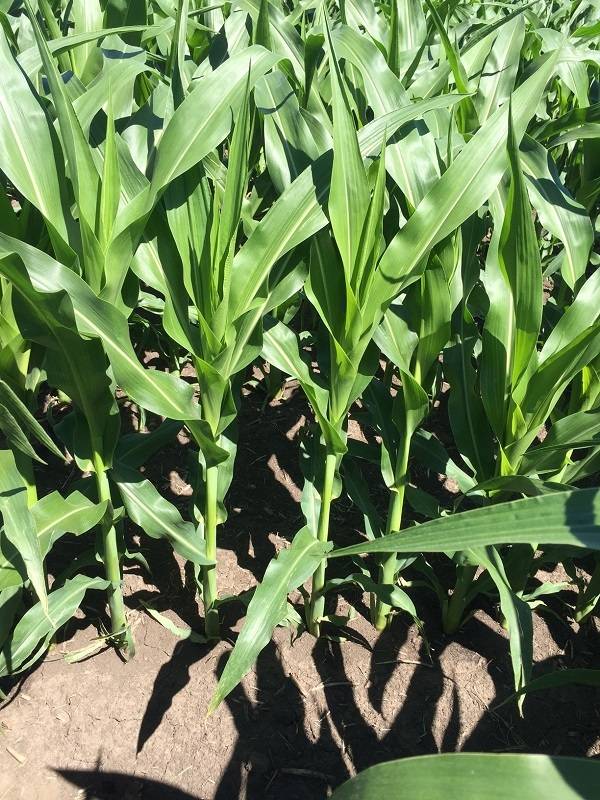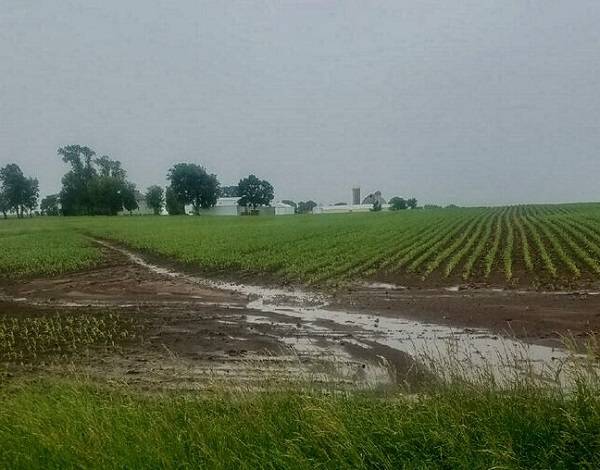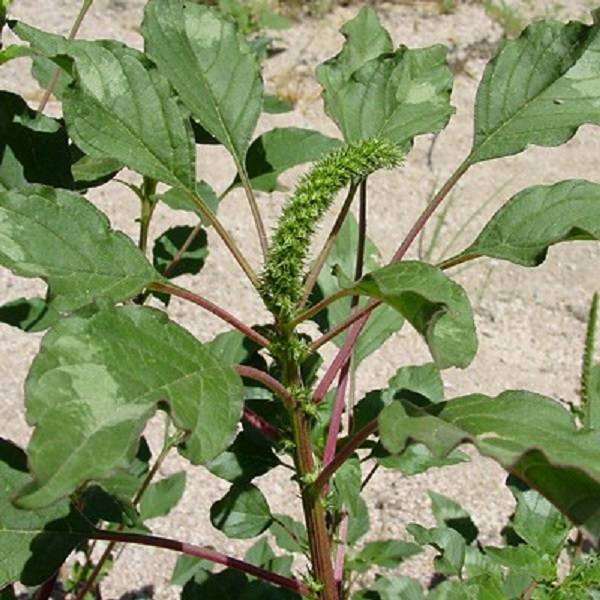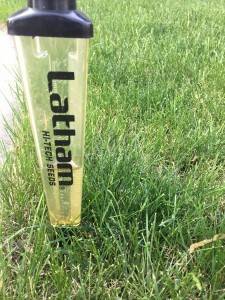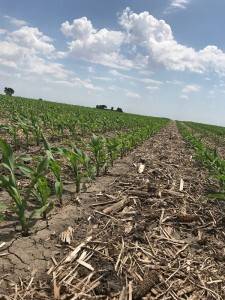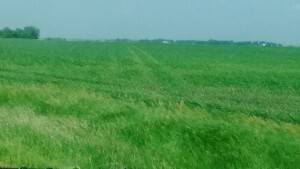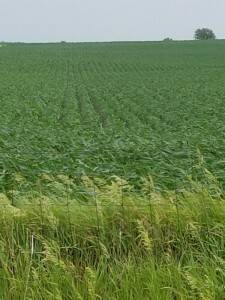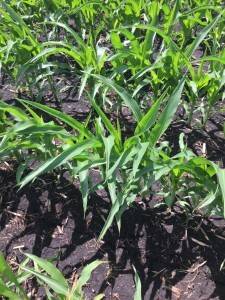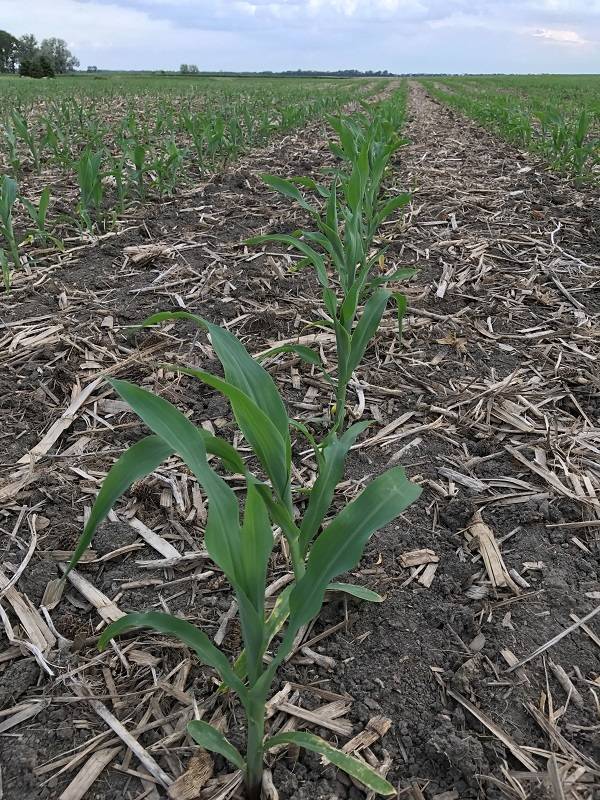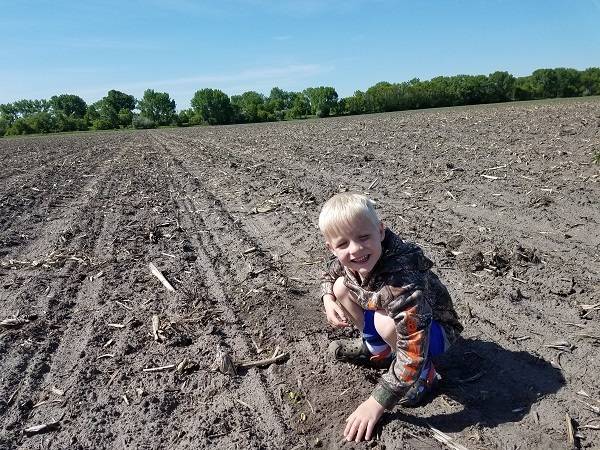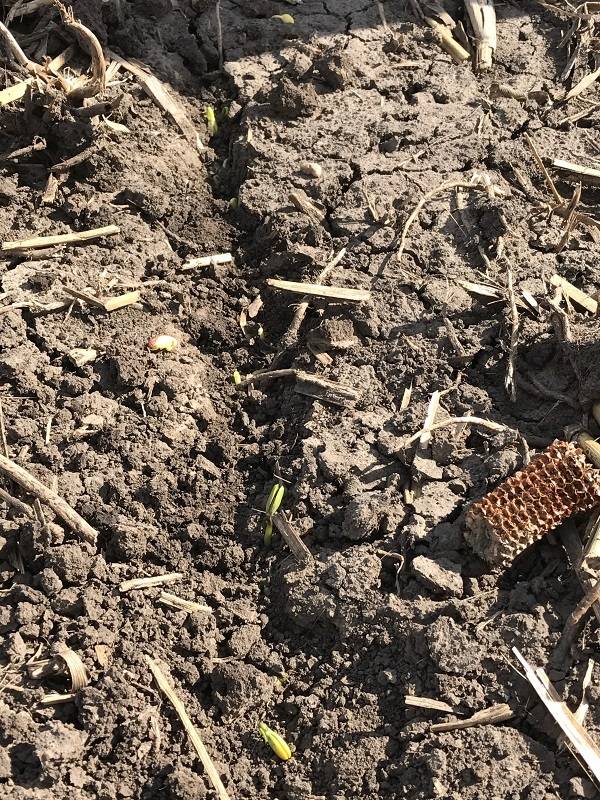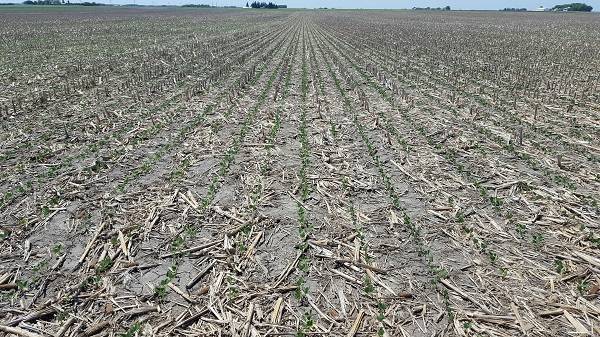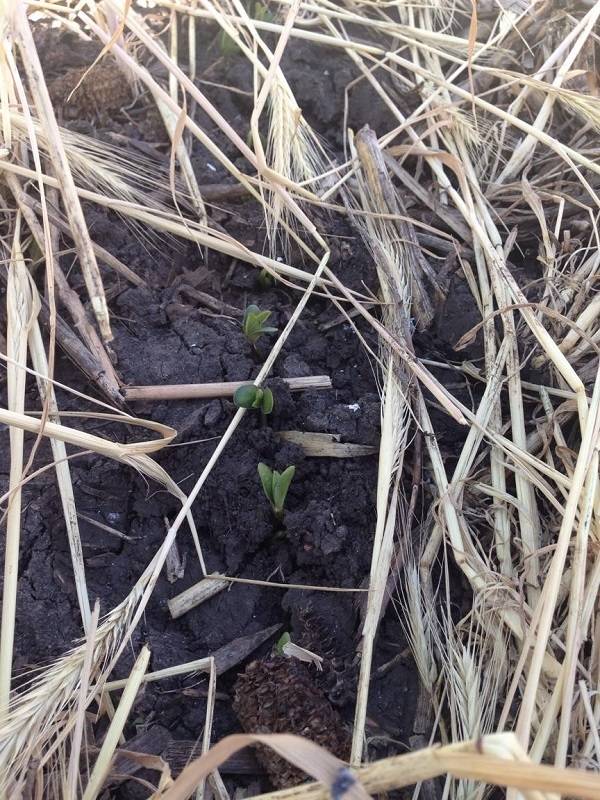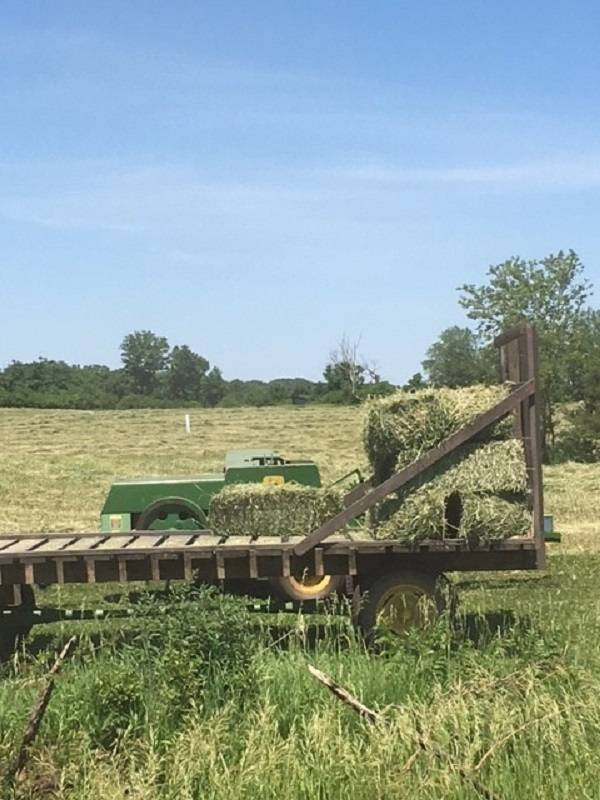Tune in below to this week’s podcast! Phil talks about key insects to watch for as your #crop17 progresses. Thanks for the topic submission! Find us on Facebook, Twitter, Instagram and Snapchat to continue submitting questions!
-
Latham Hi‑Tech Seeds
Podcast: Insect Pressure in Corn & Soybeans

-
Latham Hi‑Tech Seeds
From the Field Crop Report: July 5
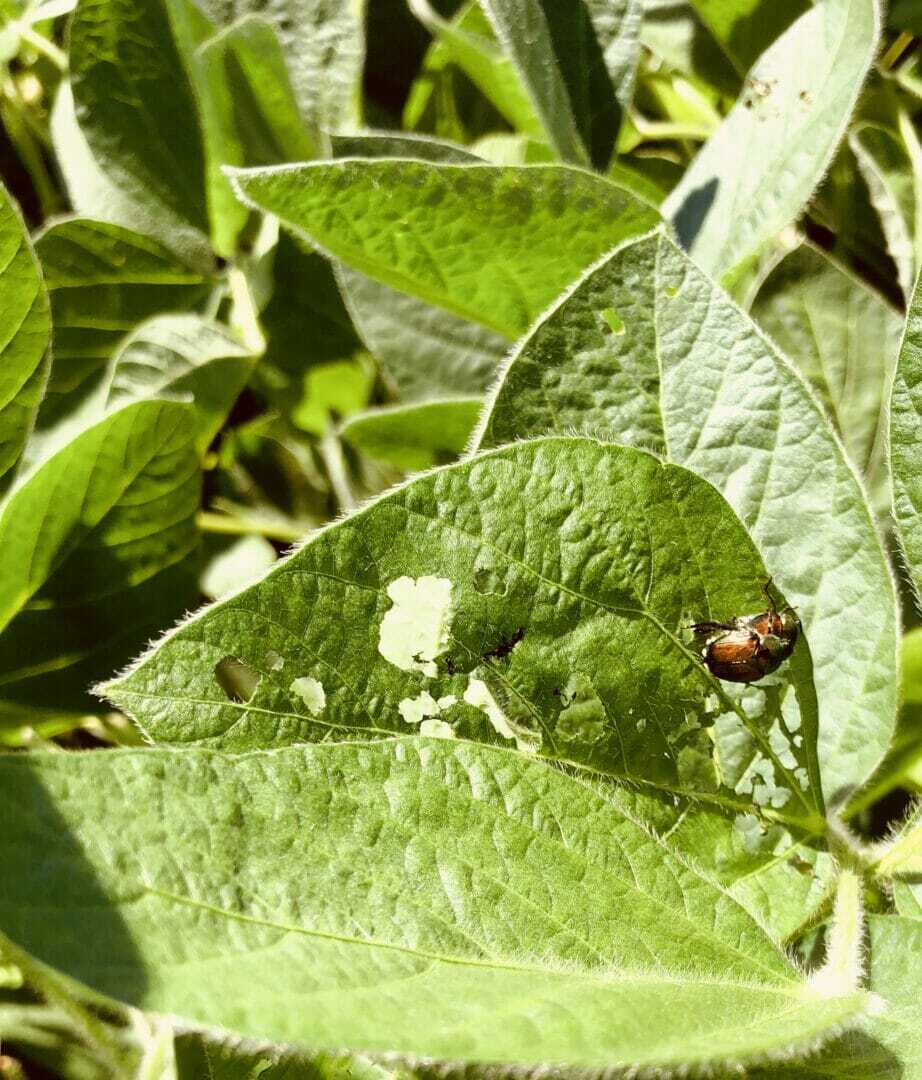
Eastern North Dakota
Brain McNamee
We have had a very troubling spring with the dry planting conditions, hail, and all the replants and now the widespread drought in North Dakota. There is a lot to feel down about, so let’s just focus on the end result and the not-so-distant past with terrific results. Here are a couple of my favorites pics from last fall.
Southeast North Dakota
Gary Geske
We had a slim chance of rain Tuesday evening, but unfortunately it went around us. It would sure be nice to pick up an inch or two before this week of extremely high temps. Corn is already under significant stress.
Northeast South Dakota
James Keltgen
Hotter weather has moved in to our region, which is both a blessing and a curse. Crops are behind normal pace and need heat units, but many areas are extremely dry and need moisture. Damage already has been done to small grains and will likely incur to row crops this week if the needed rain doesn’t fall.
Southeast South Dakota
Ramie Coughlin
Corn was well past knee-high this Fourth of July. While much of South Dakota is in a slight to moderate drought, there are still some areas in the southeast where moisture is not yet a limiting factor. The last couple weeks of June helped catch us up on GDUs. Although we’re just a little behind last year’s GDUs, we’re ahead of the 10-year average.
Northern Minnesota
Ken Highness
Twisted whorl, also called buggy whipped corn, is evident in the northern part of my sales region. I took these photos July 3 near Beltrami, Minnesota.
Although this syndrome is not fully understood by scientists, there is a correlation between its presence and weather patterns. Twisted whorl is often present when there has been a sharp transition from periods of slow corn to periods of rapid corn development, or from cool and cloudy weather to warm and sunny weather plus ample moisture.
Southern Minnesota
Brandon Wendlandt
In last week’s crop report, I mentioned that I’d be eager to see the results after spraying Xtendimax on Latham brand soybeans L 2184 R2X. This picture was take three days after application. The giant ragweed is taking more time, but the waterhemp has keeled over!
Southern Wisconsin
Greg Mair
We have had excessive moisture in Wisconsin since planting began, causing many areas of fields to be drowned out or never planted. Due to the wet spring, these Latham Seed-2-Soil Technology and Soybean SuperStrip plots were not planted until June 1 along Highway 73 near Cambridge. With this week’s projected forecast calling for high temps, we should see significant growth in the coming days.
Now that spraying has been completed, it is a great time to scout your fields. Identifying pests and determining a course of action now can potentially increase profits at harvest.
Northwest Iowa
Darin Chapman
It was a great looking day at BA Farms! Hope you all enjoyed the holiday!
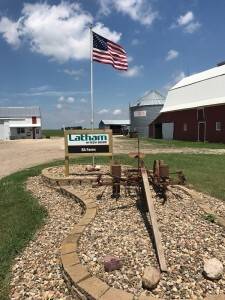
South Central Minnesota & North Central Iowa
Cory Greiman
Infection and disease is more likely after crops are damaged. To help protect their injured crop, farmers often apply herbicide after a hail event. Some foliar diseases, however, do not require wounds for infection. Foliar diseases favor rainy and/or humid weather like we’ve been experiencing here in North Iowa.
Southeast Minnesota & Northeast Iowa
Craig Haaland
This plot conventional hybrids from of Latham Hi‑Tech Seeds is planted May 9 west of Chatfield, Minnesota. Corn around this area is really starting to take off thanks to the warm temps and rainfall we’ve been getting. Remember, it’s important to keep walking your fields to stay ahead of disease and pest pressure.
West North Central Iowa
Bart Peterson
Potassium (Potash) deficiency appears as a firing or drying along the tips and edges of leaves.
Eastern Iowa
Jerry Broders
The picture below shows some of the damage from a tornado near Prarieburg.
Central Iowa
Bryan Rohe
Western Iowa & Eastern Nebraska
Larry Krapfl
-
Latham Hi‑Tech Seeds
China Approves Enlist™ Corn Trait
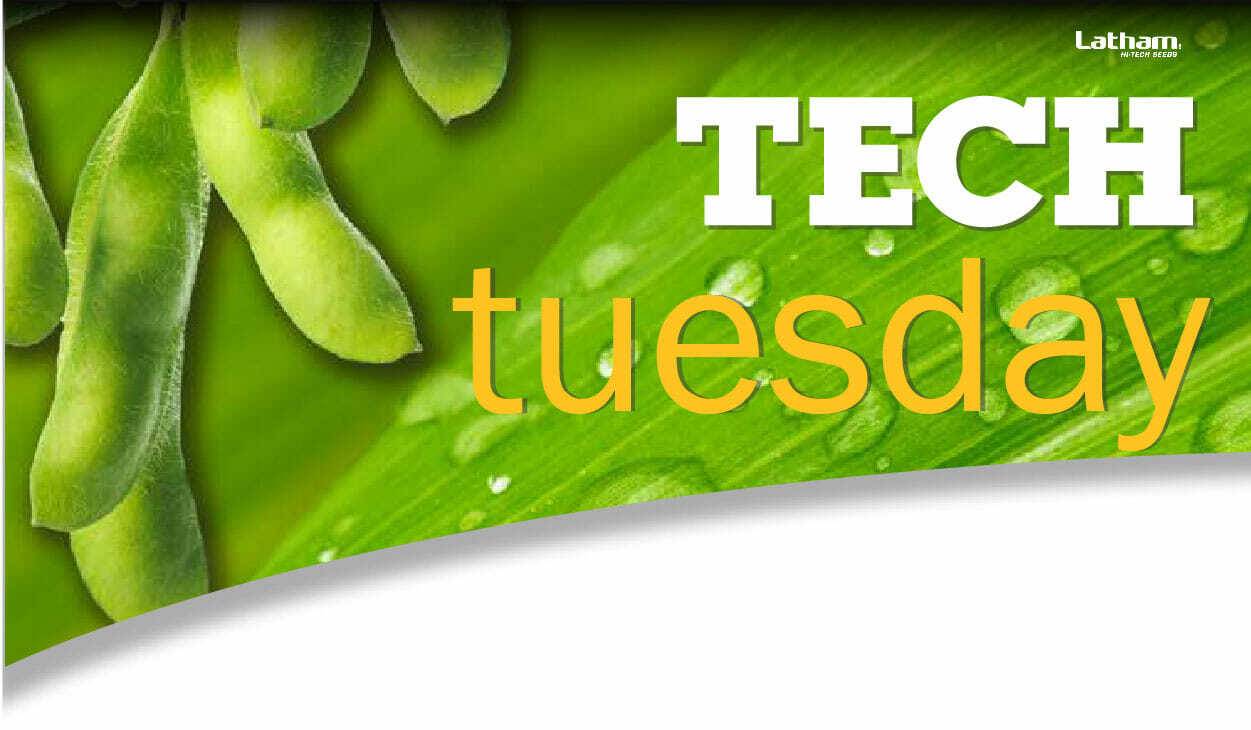
Dow AgroSciences on June 14 announced that corn stacked with the Enlist™ trait had been approved for import into China. This clears the road for U.S. farmers to plant hybrids with the Enlist trait in 2018. It’s especially good news for Latham® dealers and customers because they’ll soon have another tool to fight herbicide-resistant weeds!
The enlist system is based on tolerance to Dow AgroSciences’ new formulation of 2,4-D with Colex-D® technology. The herbicide used is called Enlist Duo®, which is a premix of this new 2,4-D compound and glyphosate. Enlist Duo herbicide may be sprayed on PowerCore® Enlist hybrids and also Enlist soybeans once that trait has been approved. PowerCore hybrids will contain the Enlist herbicide tolerance trait, as well as a VT Double PRO® and Herculex® 1 stack. These hybrids are poised to provide the best above ground control on the market!
Latham Corn Team members have been anticipating the approval of Enlist corn for several years and have identified several hybrids that can be added to our lineup under the PowerCore designation. We’re excited about adding this trait to hybrids with proven genetics, like LH 5402 RR and LH 5742 RR. We also plan to bring in new hybrids to complement our existing products.
When Enlist Duo is used with Colex-D, it minimizes drift and has almost zero volatility. This has already been proven by U.S. cotton farmers, who have been able to grow the PhytoGen® brand of Enlist cotton since it was launched in 2016. A select group of Upper Midwest corn farmers also have tested the Enlist system on carefully controlled, stewarded acres during the past couple years. In addition, the Latham Corn Team has tested Enlist hybrids in other regulated fields.
We’re optimistic that the approval of Enlist corn by China will soon lead to the approval of Enlist soybeans. As part of a trade deal with the United States, China has pledged to speed up its review of eight biotech products (including Enlist soybeans) that are pending approval. More information about PowerCore and Enlist hybrids, as well as Enlist soybeans, will be shared during our Seed-2-Soil® Technology Tour this fall. Make plans to join us in a field near you!
-
Latham Hi‑Tech Seeds
From the Field Crop Report: June 28
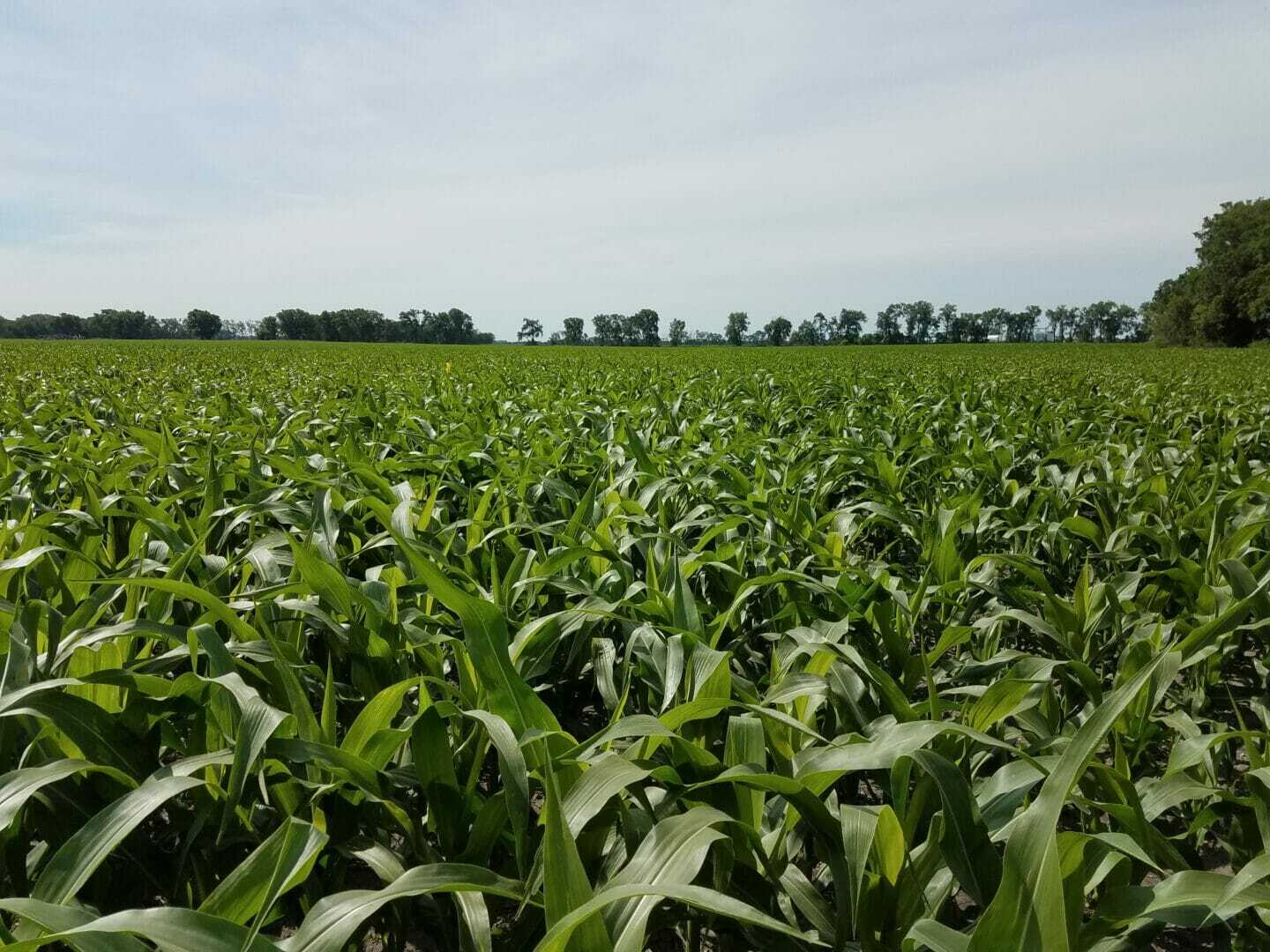
Eastern North Dakota
Brain McNamee
An example of imbibitional chilling effect in Northern North Dakota. Due to cold, wet spring conditions, I’m seeing more cases of imbibitional chilling and soil compaction on more acres this growing season.
Southeast North Dakota
Gary Geske
We’re expecting a big crop near Enderlin, North Dakota! Two slabs are ready for 35,000-bushel grain bins.
Northeast South Dakota
James Keltgen
Strong and severe storms came through Northeast South Dakota last Wednesday morning. Winds of 20 miles per hour (mph) combined with a 20-minute hail storm, leaving 2.5-inch drifts, south of Watertown. Crops and buildings were completely destroyed. There is still a fair amount of replant being put in due to the hail and poor stands from lack of moisture.
Northern Minnesota
Ken Highness
This field of Latham 4454 VT2 PRO RIB was planted April 15 near Glyndon, Minnesota. According to an old farm adage, having corn knee-high by the Fourth of July was an important bench mark for your corn crop. Growing condition have been very favorable so far, and this farmer expects to have a good crop.
Southern Minnesota
Brandon Wendlandt
XtendimaxTM was sprayed June 26 on this field of Latham® Hi‑Tech Soybeans L 2184 R2X. This photo shows glyphosate-resistant waterhemp and giant ragweed, so we’re eager to take a look at this field next week!
Southern Wisconsin
Greg Mair
Latham® brand soybeans with the LibertyLink™ trait, pictured on the right, were planted before the rain and into good soil conditions. The Liberty soybeans on the left, however, were planted the day after the rain into wet soil conditions. Compaction is evident in the field. This portion of the field also crusted over severely affecting the emergence.
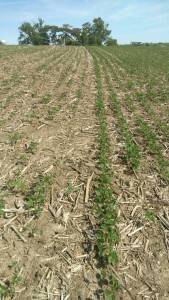
This photo emphasizes the important of planting into good soil conditions. Click here for Top 10 reasons to avoid soil compaction. Northwest Iowa
Darin Chapman
We continue to receive plenty of rainfall in Northwest Iowa along with cooler temps. Heat degree units would be beneficial!
South Central Minnesota & North Central Iowa
Cory Greiman
It’s that time of year when Iron Deficiency Chlorosis (IDC) rears its ugly heads. Not all soybeans have the defensive package needed as evident in this field planted to a competitor’s soybeans. Keep in mind that Latham® IRONCLAD is Your Best Defense Against IDC.
Southeast Minnesota & Northeast Iowa
Craig Haaland
This Latham Soybean SuperStrip plot was planted May 13 north of Blooming Prairie, Minnesota, We have received adequate rainfall so far this growing season. In fact, corn and soyean fields have really changed during the last week to 10 days. It’s been amazing to watch how quickly the replanted acres have caught up with the rest of these fields. Remember to scouting your fields. Mid-season scouting is necessary to stay ahead of weeds, insects and pests!
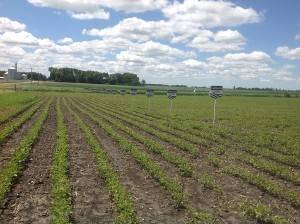
West North Central Iowa
Bart Peterson
Lots of spraying has been taking place in West Central and North Central Iowa this week. Here’s we’re spraying Liberty beans near Woolstock, Iowa, during a beautiful sunrise.
Eastern Iowa
Jerry Broders
The two photos I’m sharing this week demonstrate the resilience of corn to hail damage. One photo was taken on June 14 and the other photo was taken of the same field on June 26.
Central Iowa
Bryan Rohe
Iron Deficiency Chlorosis is showing up in some soybeans fields in the area. Remember, your best defense against IDC is planting IDC-resistant soybean brands. Latham Hi‑Tech Seeds makes that easy to do with our IRONCLAD designation. These soybean fields near Story City, Iowa, are planted to Latham® brands L 2084 R2 and L 2228 R2.
Western Iowa & Eastern Nebraska
Larry Krapfl
In last week’s crop report, I began talking about the evasive weed of Palmer Amaranth. This aggressively invasive weed was found in only 5 of Iowa’s 99 counties at the beginning of 2016 but has spread to more than half the state’s counties now. Early identification is key to managing Palmer Amaranth, which is nearly identical to waterhemp.
Another noxious weed that’s drawing serious attention is Wild Parsnip, which is commonly found in Iowa road ditches. Wild Parsnip might be confused with a wild flower, but don’t cut it for a bouquet! Touching this poisonous plant could land you in the emergency room! Sap on the plant causes a reaction on skin that turns into painful blisters, boils and scarring. Experts say if you do come into contact with the plant, to wrap up the area immediately to protect it from sunlight.
-
Latham Hi‑Tech Seeds
From the Field Crop Report: June 21
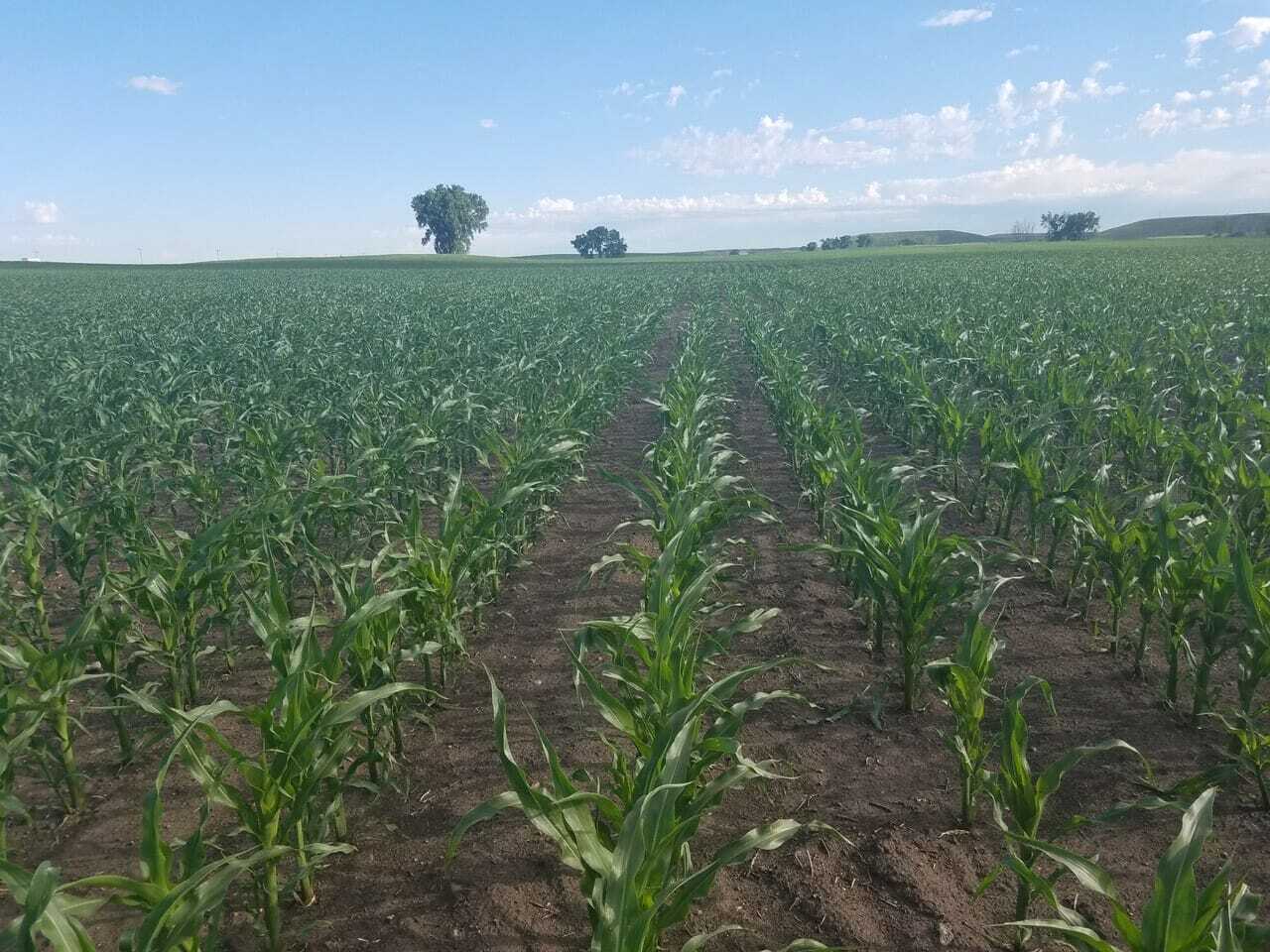
Eastern North Dakota
Brain McNamee
You can definitely see where pre-emergence herbicides worked and where they didn’t. There are many environmental reasons, mainly dry weather, leading to really catastrophic weed control.
Look at the Roundup Ready canola coming in this picture. You can see chemical-resistant weeds are a growing problem. This farmer will have not only a more expensive chemical bill, but his yield will be significantly less.
Southeast North Dakota
Gary Geske
You’re right… this photo isn’t North Dakota. This field happens to be near Percival, Iowa. As a corn product specialist for Latham Hi‑Tech Seeds, I look at hybrids in multiple locations across eight states to take notes on stress tolerance and hybrid vigor.
Northeast South Dakota
James Keltgen
After the wild week of weather we experienced last week, things have mellowed down. Winds of 90+ miles per hour accompanied last week’s storms, ripping roofs off buildings, uprooting trees and blasting young crops. There has been a fair amount of soybeans replanted, and corn was hailed out in some areas.
Southern Minnesota
Brandon Wendlandt
Doing some crop scouting LH 5095 VT2, which is nearing the v7 growth stage. Now is a great time for lots of different scouting in corn. You can scout for herbicide effectiveness, plant health, bugs, and roots. Digging roots can tell you a lot about your soil structure, tillage decisions, and planting.
Southern Wisconsin
Greg Mair
After a wonderful crop year in 2016, #crop17 has Wisconsin farmers scratching their heads. Latham® dealer Adam Faust of Chilton continues to experience wet weather. Northeast Wisconsin has received 7 inches (and counting) of rain this past week, causing washouts and flood warnings. In some areas, road crews put plows on the trucks to move the mud and field debris off the road.Photo Credit: Adam FaustNorthwest Iowa
Darin Chapman
Latham Hi‑Tech Seed corn and soybeans are progressing nicely in Northwest Iowa! We are looking forward to the results we see this fall. Stop by our Field Day on August 31 and see how #crop17 is coming along.
South Central Minnesota & North Central Iowa
Cory Greiman
Soybean emergence is uneven due to dry conditions when planted. Now that rain has fallen, more seeds are germinating.Southeast Minnesota & Northeast Iowa
Craig Haaland
This Latham® soybean plot was planted May 5 in Floyd County and was sprayed on Sunday. Fortunately, last week we received a total of one inch of much needed rain. Keep scouting your corn and soybean fields to stay ahead of any weed, insect or disease issues.West North Central Iowa
Bart Peterson
Got a kick out of this scene as I drove into the yard of a Latham dealer’s yard in West Central Iowa. Corn is in the V6 development stage and soybeans are between V1 and V3. We are not desperate for rain, but it is welcomed!
Eastern Iowa
Jerry Broders
We had a hail event go through the region on June 14, causing widespread damage in Linn County.
Central Iowa
Bryan Rohe
Hail the size of golf balls and baseballs caused severe crop damage around Earlham, Iowa. Many fields in the area are a complete loss.
Western Iowa & Eastern Nebraska
Larry Krapfl
It is that time of year to keep a watchful eye on fields for the most feared weed in the industry… Palmer Amaranth. This is a stock photo of an image that all producers should have seared into brains.
-
Latham Hi‑Tech Seeds
From the Field Crop Report: June 14
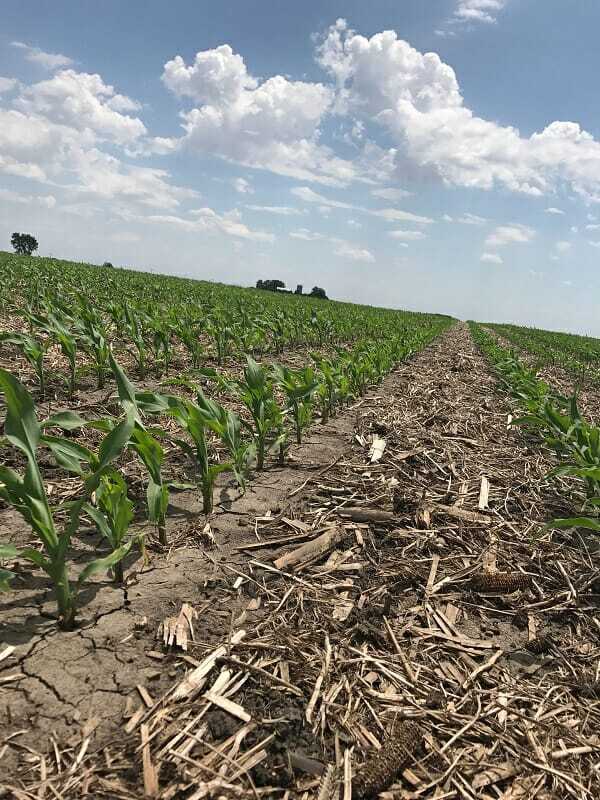
Eastern North Dakota
Brain McNamee
The good news is that rain finally fell in some drought-stricken areas. Too bad last weekends weather event also delivered damaging hail as pictured in this field near Rugby, ND. This field was a total loss with less than 5% viable plants left.
Fortunately, the two showers that followed this storm delivered more rain and zero hail.
Emergence before the storm was very erratic, causing plant stand evaluations to be difficult. Because we haven’t had rain for so long, soybeans were planted into dry dirt and laid dormant for three weeks.
You know the hail damage is bad when cattail sloughs look like this!
Southeast North Dakota
Gary Geske
My grandkids helping scout a field of Latham LH 3877 VT2 PRO RIB.
Mid-season crop scouting is important for two reasons: (1) different weed, insect and disease pressures become evident this time of year; and (2) summer months are a crucial time to decide which traits to implement when buying seed for the next crop year. Click here for more crop scouting tips.
Northeast South Dakota
James Keltgen
It’s been an active week of weather in NESD. 3-6 inches of rain fell in the Clark and Watertown areas. Damaging winds and hail leveled fields northeast of Watertown. The good news is rain fell in the worst drought areas in central SD this week. There has been damaging storms this weekend in SD the last 3 years. Growers are baling winter wheat for feed near Gettysburg. Spring wheat may be too short to cut. Pastures are brown but corn and soybeans held on long enough to catch rains.
Southeast South Dakota
Ramie Coughlin
Look what’s cropping up in Southeast South Dakota… This week my family and I welcomed our fourth member. Daxton Ryan said hello to the world at 12:40 am on June 13, weighing in at 6 pounds, 15 ounces and stretching to 20 inches long. He is loving life on the outside, and we are loving life with him!
Northern Minnesota
Ken Highness
My grandson Casen and I are doing root digs on Latham’s experimental corn varieties in a SuperStrip plot near Felton, MN. This plot was planted May 7. At this stage, the root mass is well developed. The very white roots indicate an excellent healthy plant.
Southern Minnesota
Brandon Wendlandt
Storms came through much of southern Minnesota on Sunday and Monday and brought much needed rain. While some areas reported more, I received 2 inches of rain at my house. Some small hail was reported with the storm, but we haven’t seen crop damage from it here. Other areas did receive damaging hail and winds, so it will take a few days to assess the damage and decide a course of action.
Southern Wisconsin
Greg Mair
The cold, wet spring has caused stand reductions in all crops across the Corn Belt. A final stand evaluation is a key component to yield at harvest.
Using the Hula-Hoop method for soybeans, we determined this location in Deerfield, Wisc. had an average stand of 130,000 plants per acre (ppa). We threw a 36″ hula-hoop around the field and calculated the number of plants within by the corresponding factor (6,165) to get plants per acre. Click here for more tips on assessing corn and soybean stands.
Northwest Iowa
Darin Chapman
Check out the picket fence stand and great emergence from Latham’s LH 4955 VT2 PRO!
Northwest Iowa just received a couple shots of much needed rain in the last couple of days. Unfortunately, some received damaging hail with that rain.
South Central Minnesota & North Central Iowa
Cory Greiman
When spring weather is wet, some farmers get overly anxious about getting seed in the ground. We understand their sense of urgency, but we also know they’ll have better results if they wait for more suitable field conditions. Here’s a case in point see the wheel track compaction in a corn field due to working it when soils were too wet?
Top 10 Reasons to Avoid Soil Compaction:
- Causes nutrient deficiencies
- Reduces crop productivity
- Restricts root development
- Reduces soil aeration
- Decreases soil available water
- Reduces infiltration rate
- Increases bulk density
- Increases sediment and nutrient losses
- Increases surface runoff
- Damages soil structure
Click here for tips to avoid soil compaction.
Southeast Minnesota & Northeast Iowa
Craig Haaland
This nice looking field of LH 5010 conventional corn was planted around May 7 in Dodge Center, Minnesota. Fortunately, we’ve finally received some much needed rain. This hot, humid weather pattern is sticking. It’s going to be important to scout your fields to stay ahead of any insect and disease pressure. Scouting fields also can help you note changes needed to your 2018 crop plan.
West North Central Iowa
Bart Peterson
LH 5095VT2 PRO, planted April 11, near Rolfe in West Central Iowa has already canopied. Corn is at V6 to V7 stage.
Eastern Iowa
Jerry Broders
Time of planting and soil conditions have played a huge role in soybean emergence this planting season.
These photos were taken last week at planting time. Dry soil needs rain to help move along these plants.
Central Iowa
Bryan Rohe
High heat and no moisture is casing corn plant in Central Iowa.
Western Iowa & Eastern Nebraska
Larry Krapfl
Photo 1
LH 3158 LL planted April 18 full shade on the 15-inch rows
Photo 2
This field of LH 6317 VT2 PRO DG RIB, which was planted April 12, will be knee high before the 4th of July.
Photo 3
LH 6175 VT2 PRO RIB is nearly waist high on this Latham dealers farm in western Iowa
-
Latham Hi‑Tech Seeds
Crop Scouting Can Lead to Seed Selection in 2018

While you may not get paid directly to walk your fields, I can say without a doubt that it will pay for itself. Mid-season crop scouting is important for two reasons: (1) different weed, insect and disease pressures become evident this time of year; and (2) summer months are a crucial time to decide which traits to implement when buying seed for the next crop year.
By walking fields, you can catch any type of stress early that enhances the likelihood of opportunistic insects such as corn leaf aphids, European corn borer and armyworms. High humidity and heavy dew creates ideal conditions for diseases like we saw last season with Northern Corn Leaf Blight (NCLB).
Black cutworm could be a larger problem this year as they’re known to cause more damage in fields where corn is planted later, and quite a few acres were replanted due to heavy spring rains and ponding. Fields of higher risk also include those that are poorly drained and low-lying; those next to areas of natural vegetation; and those that are weedy or have reduced tillage.
The wide variance in planting dates also may cause rootworm beetles to move between fields. A late-maturing corn field may attract large numbers of beetles if neighboring corn stopped producing pollen, for example. Rootworm beetles may also move into corn and/or soybean fields that have an abundance of pollen-producing weeds, including volunteer corn, ragweed or foxtails.
Controlling weeds will help control corn rootworm populations, as well as other insects like Two-spotted Spider Mites and aphids. Mites and aphids begin feeding along field edges, especially in weedy areas, before eventually developing into a field-wide infestation.
Noting weed infestations can provide you with an opportunity to discuss this with your Latham Dealer and allow them give you to suggestions to mix up modes of action when selecting next year’s seed products. Latham’s Regional Field Days display the trait options available for 2018 planting. Make plans now to attend one of these regional plot days and discover more about the options Latham has to offer next year! Stay tuned for updated information about field day dates and locations in the coming editions of TECHtuesday.
-
Latham Hi‑Tech Seeds
Podcast: Soybean & Corn Replant

Welcome back to our Ask the Agronomist Podcast! Phil is traveling across Latham Country this week and gives us a update form the field, with an emphasis on replant.
0:45 — From the Field update
1:30 — Is replant still on the minds of famers in Latham Country?
4:30 — Weed Pressure
5:15 — Stand counts & uniformity
7:25 — When does replant date compromise yield?
9:10 — Interplanting in your fields?
Thanks again for tuning in! Find us on Facebook, Twitter or Instagram to submit your agronomy questions. See you back next week!
-
Latham Hi‑Tech Seeds
From the Field Crop Report: Week of June 7
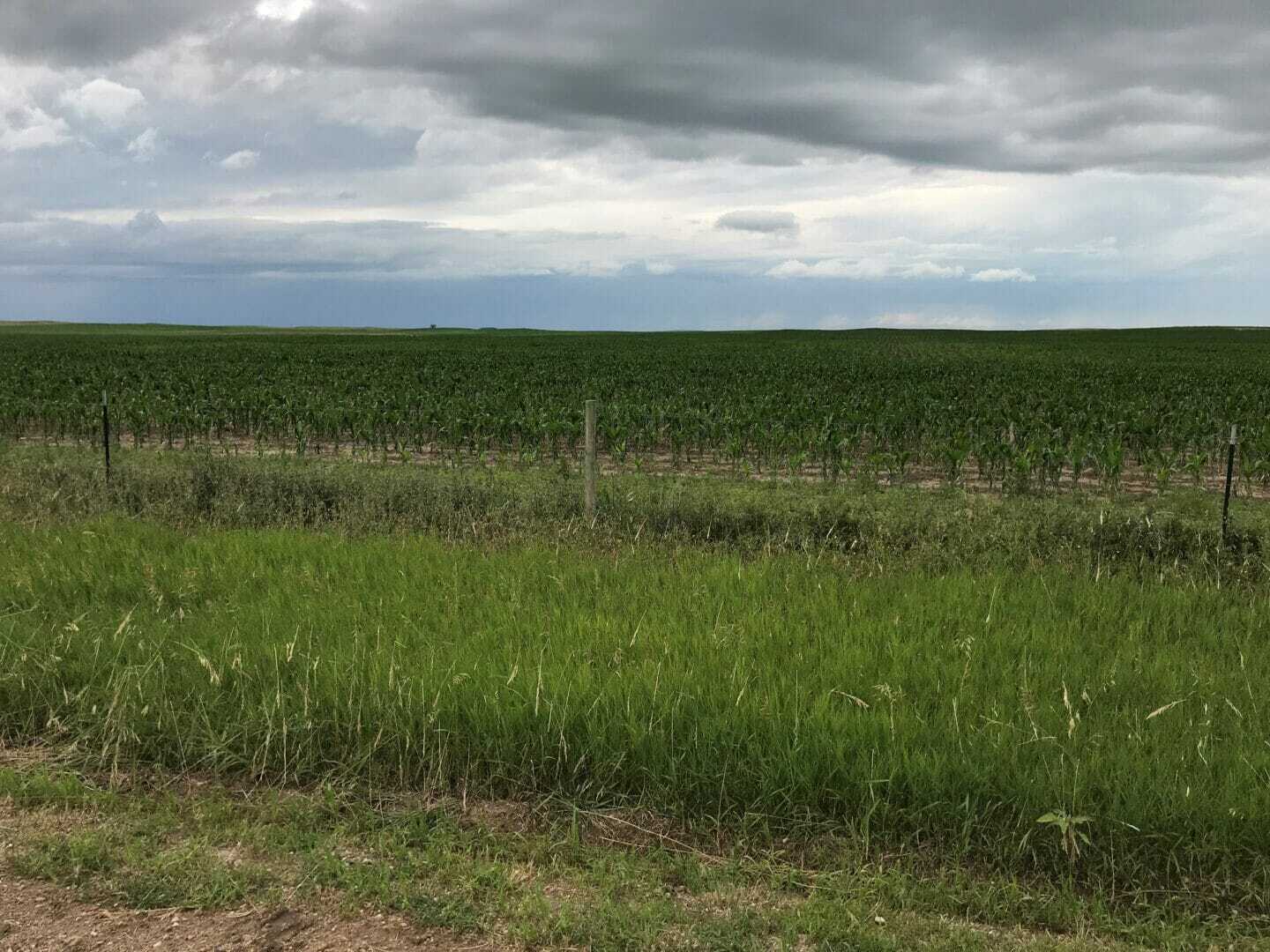
Eastern North Dakota
Brain McNamee
We talk about the importance of field-by-field placement, and here’s a textbook example. I was driving around my territory when I saw this field and stopped to visit with the farmer about his situation.
Given the weed pressure in this field, different soybean seed technology should have been used. One advantage of working with independent Latham Hi‑Tech Seeds is that we sell all technology platforms, so we can work with farmers to help them chose the best system for a given situation.
If this particular farmer could have a do-over, he would have selected a different pre-emergence herbicide. A full quart of Powermax® and Authority® Assist did nothing to this marestail. Fortunately, an agronomist found a recipe to take care of 90% or better of these glyphosate-resistant buggers.
Northeast South Dakota
James Keltgen
Rain has yet to fall in the areas where it’s needed the most. Rain is desperately needed as both corn and soybeans have yet to emerged due to dry soils. In areas that received moisture, the heat is moving corn development along. Soybeans range in stages. Wet spring weather in some areas delayed planting, so farmer there are working to finish now.
Photo 1: LH5095VT2 nearing V5 stage
Photo 2: Soybeans aren’t poking through yet
Southeast South Dakota
Ramie Coughlin
We’re starting to be able to row soybeans. Some plants even have the first trifoliate. Click here to see what each stage of plant growth looks like.
Northern Minnesota
Ken Highness
My grandson Braxton and I were scouting a soybean field near Glyndon, Minnesota, for emergence and symptoms of any seedling diseases.
Southern Minnesota
Brandon Wendlandt
A customer invited me to walk this field with him late last week. He was very impressed with his Latham® hybrids and was excited to show me the emergence of LH 4455 VT3 PRO RIB. This field was planted April 20 with a population at 35,500. The right half of this picture shows LH 4455 VT3 PRO RIB, and we assessed stand counts at 35,000 plants! The left half of the picture shows the competitor at 26,000 plants.

Southern Wisconsin
Greg Mair
Wisconsin’s wet and cold weather has straightened out! We’re finally getting sun and heat. I can’t believe I am saying this, but some of the later planted fields could actually use a shower. Around Janesville, Wisconsin, almost all of the soybeans are popping through the soil. This field of Latham® IroncladTM 2084 R2 Soybeans, which was planted on May 31, shows great growth in just one week.
Northwest Iowa
Darin Chapman
Following another wet spring, farmers in Northwest Iowa are in a position where they have to make the difficult decision whether or not to replant due to heavy rains, drowned outs, and crusting. The timing of rainfall is key, and we could use a gentle shot of rain here in Northwest Iowa!
South Central Minnesota & North Central Iowa
Cory Greiman
You see some interesting things while scouting fields. Pink colored seed treatment shell is still on cotyledons of this emerged soybean plant.
Southeast Minnesota & Northeast Iowa
Craig Haaland
This field of Latham® 2084 R2s was planted May 14 in 7.5-inch rows at 140,000 population into no-till. It’s looking good considering no rain has fallen since then in Mitchell County. Our crops could really use a drink.
West North Central Iowa
Bart Peterson
If you look closely, you can see soybeans poking their heads above the ground into the dead rye cover crop. Marvin Beneke, a Latham dealer from Palmer Iowa, sent to pic to me last week.
Eastern Iowa
Jerry Broders
Many farmers are apply post-emerge herbicides on corn and soybeans. For best results, it’s important to follow label directions on all post-herbicide applications. Remember, it’s is not the height of the corn that matters but rather the stage of growth.
Also be sure to keep an eye on your crops for cutworms and army worms. They are out there and can be devastating on your corn crop.
Central Iowa
Bryan Rohe
You know what they say, “make hay when the sun shines.” This week lots of mowing, raking and baling is being done across Central Iowa.
-
Latham Hi‑Tech Seeds
Plant into the Best Seedbed Possible

One of the things I like most about spring is you get to enjoy all four seasons in just a few days. In mid-April, we had snow flurries with an overnight low of 16 on a Sunday. A warm wind brought temperatures into the 70s by mid-week, and that weekend rain fell. That’s why I always tell people to plant by the conditions, not the date on the calendar!
Soil conditions are far more important than planting date. Rather than mudding in your seed to say that it was planted early, you’ll have a better chance of achieving maximum yield by planting into properly tilled soil. Working soils that are too wet leads to yield loss and more problems during the growing season from soil compaction. Restricted root development, nutrient deficiency and reduced infiltration rate are among the top 10 reasons to avoid soil compaction.
Adapted full-season corn hybrids can compensate somewhat for later plantings. As planting is delayed, hybrids shorten the time between planting and silking. Research shows that development and final yield of these hybrids will not be largely affected unless frost occurs especially early in the fall. That’s why we recommend waiting until May 15 in North Dakota and May 25 in Iowa before switching to an earlier maturing corn hybrid or switching to soybeans.
Patience is also key when planting soybeans. Planting into a field that is too wet will reduce emergence and plant population, which most often leads to reduced yield. Another cause of reduced yield is weed pressure. Make sure the sprayer is right behind the planters. Otherwise, soybeans might poke through the ground before your pre-emerge was applied.
We get one chance every spring to create the best seedbed possible for planting, so let’s take advantage of it! This may require a different piece of tillage equipment than originally planned, but taking the time to make the equipment switch will pay big dividends by resulting in better seed-to-soil contact that enhances germination and early growth.

